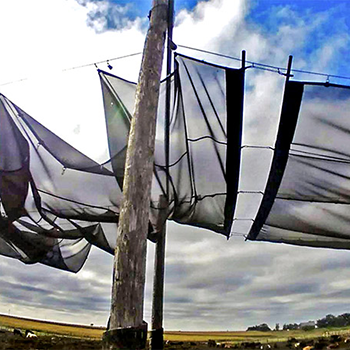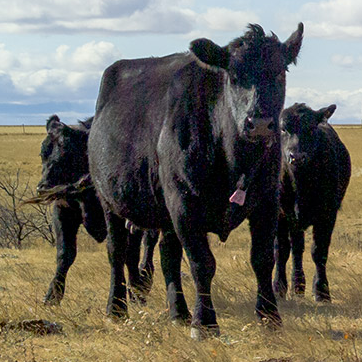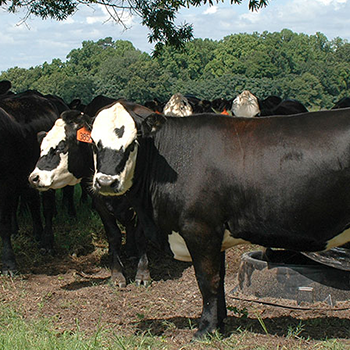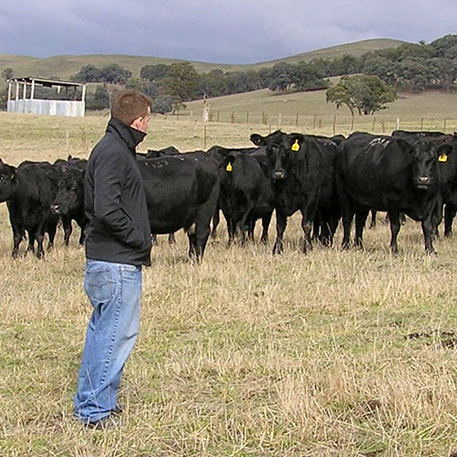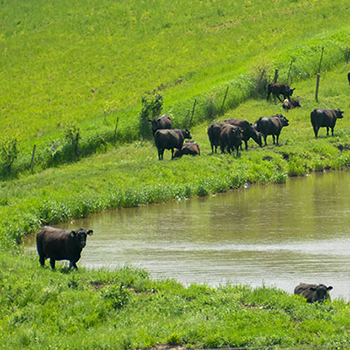Angus Advisor
Our team of Angus advisors offer regional tips for herd management for the summer season.
Southern Great Plains
david.lalman@okstate.eduThe backlog of fed cattle caused by the coronavirus pandemic will create a ripple effect throughout our industry for months. Thankfully weekly cattle harvest and feeder-cattle market conditions were beginning to improve at the time of this writing in late May. Even so one indirect effect sure to be felt by seedstock producers is increased pressure on grazing and harvested forage resources throughout this growing season and coming winter.
For example, feedyard placements were the second lowest for April since the series began in 1996. Excellent spring cool-season annual and perennial forage growing conditions provided some cushion to allow delayed feeder-cattle delivery or increased heifer retention. In late May, however, drought conditions were expanding in the western half of the region, while moisture conditions were rated “good” to “excellent” in the eastern half.
From a broad perspective, increased grazing pressure coupled with possible drought conditions magnifies the importance of thoughtful grazing management.
Overgrazing leads to long-term damage of the ecosystem and rangeland productivity. A longtime standard recommendation is to destock early as drought conditions develop. Fortunately, cull-cow prices have held up reasonably well compared to prices for other classes of cattle. This may be a year to cull deeper into the cow herd for late calving, udder and foot structure, docility, hair shedding, and marginal or undesirable expected progeny differences (EPDs).
For producers who traditionally use continuous grazing with a moderate stocking rate, current conditions may encourage implementation of a management-intensive, rotational grazing system. A primary incentive is increased harvest efficiency available through a more intensive rotational grazing system. While intensified management and a more extensive fencing system are required, more of the less-palatable plants and plant parts are harvested by the cattle. Pastures are grazed more uniformly, leading to increased carrying capacity while providing periods of rest and forage regrowth.
In areas where moisture is adequate or abundant, a mid- to late-summer fertilizer application in Bermuda grass pastures should be considered. An additional 50 pounds (lb.) of nitrogen (N) per acre should increase forage production by about 1,500 to 2,000 lb.
Consider purchasing hay for winter feeding and grazing hay meadows. Purchasing outside hay increases ranch carrying capacity and imports soil nutrients. Feed hay in less-productive areas if possible to improve soil fertility and organic matter. If possible, roll hay bales out to ensure better hay waste distribution, manure distribution and less sod destruction from trampling (compared to feeding in a hay ring).
Seedstock operations should be considering winter supplement and growing ration feed ingredient alternatives. At the time of this writing, distillers’ grains, a highly popular protein and energy supplement, have become scarce and expensive. During mid-summer, producers should be comparing cost and convenience of alternatives, especially for supplemental protein sources to enhance utilization of low-quality forage.
Less feed grain channeled to ethanol production suggests more feed grain may be available at a lower cost to the livestock industry. Therefore, drylot feeding programs based on a greater proportion of concentrate feed and less forage may require serious consideration this summer and fall. For example gestating beef cows can be maintained with around 11 to 14 lb. (depending on cow size) of concentrate feed and 6 lb. of forage. These programs are not for everyone, as more intensive management is required along with feed ingredient storage facilities, mixing capabilities and feeding equipment. OSU Extension Fact Sheet AFS-3028 provides detailed recommendations and considerations for limit-feeding management of beef cows.
Many seedstock producers in the Southern Great Plains use small-grains pasture to provide high-quality grazing for weaned calves and cow-calf pairs through late fall, winter and early spring. Genetic improvement, variety testing and management recommendations are ever-evolving, so be sure to check your land-grant institution’s small-grains or wheat website for the latest developments and recommendations: Kansas State University, Oklahoma State University, Texas A&M University. In recent years, the Oklahoma State group has studied two important forage production traits among wheat varieties: fall forage production and first hollow stem date. The most recent update of this work is available in publication number CR-2141, which can be found at facts.okstate.edu.
Western Region
randyp@csufresno.eduFall-calving herds Cows are on cruise control. Precalving vaccinations: If any precalving vaccinations such as a scour vaccine are going to be used, now is the time to decide on the specific products and to get the products on hand.
Trace minerals: Be sure cows are receiving adequate levels of calcium, phosphorus and trace minerals deficient in your area. Multimin® is an excellent injectable product if that is a preferred route of administration. Copper and selenium boluses are available and a very effective means of delivering trace minerals over an extended period of time.
Body condition: The target level of body condition at calving is a minimum body condition score (BCS) of 5.0 for mature cows and 6.0 for 2-year-old heifers on a scale of 1 to 9.
Supplementation: Mid-summer is typically a time of the year when fall-calving cows will maintain themselves adequately with no need for either energy or protein supplementation, as long as forage is available to them.
Developmental period: The developmental period from weaning until breeding time is critical in terms of influencing the future productivity of females. Females should be developed to reach approximately 55% of their projected mature weight at the start of the breeding period.
Spring-calving herds Breeding season and suckling calf health. Artificial insemination (AI): Depending on desired calving dates, the AI breeding period should be concluded. Monitor return heats and clean-up bull performance for any problems that may arise.
Minerals: Be sure cows are receiving adequate levels of calcium, phosphorus and trace minerals deficient in your area. Consider chelated mineral products, especially prior to calving and through the end of the breeding season. See the comments above on injectable and bolus mineral products.
Energy balance: Energy balance has a major influence on fertility. It is critical cows are in a state of positive energy balance or gaining weight during the breeding season. If cows are grazing irrigated pastures, they are usually fine in terms of being in a state of positive energy balance.
Suckling calves: Treatment protocols and products should be on hand for scours and pneumonia in suckling calves. It is best to have two treatment options for both conditions, and be sure treatment protocols have been communicated to the appropriate personnel.
General management Irrigation: If irrigated pastures are part of your forage resources, timely irrigation during hot summer months is critical in terms of affecting forage production. Mid-summer is also an excellent time to control thistle or other invasive weeds in pastures.
Pinkeye: Mid-summer is the time of the year when problems with pinkeye can become quite prevalent, and thus treatments can become very time-consuming. The incidence of pinkeye can be reduced by clipping tall, mature grasses, and controlling flies with dust bags, pour-ons, fly tags and/or mineral products that have fly deterrent products included. In addition, availability of shade helps to reduce the incidence of pinkeye. It is important to treat problems quickly and aggressively, reducing the spread of the disease by flies.
Antibiotics: Antibiotics such as the long-acting oxytetracyclines are very effective in treating pinkeye. We have also had success with squirting 2 to 3 cc of Nuflor® directly into the infected eye. A more inexpensive treatment option — but one that is more difficult to administer — is to treat the infected eye with an injection of 2 to 3 cc under the membrane that covers the upper portion of the eyeball with a mixture of 90% penicillin and 10% dexamethasone. We make up the mixture by buying a 100-ml bottle of penicillin at the beginning of each summer, pulling out 10 ml of product and replacing it with 10 ml of dexamethasone.
Patches: Most people prefer to apply patches to infected eyes, and those can be made very easily from old, worn-out jeans. Leave the bottom portion of the patch unglued so the eye can drain.
Southeast Region
jduggin@uga.eduPositivity is a trait we must harness. We live in a wonderful nation, and we are blessed beyond measure. With that said, we have to work for it. It’s apparent we will have to sharpen our pencil relative to the cow herd. As much as we would like to find the miracle potion to make it all better, it’s going to be the good old-fashioned basics that will help cow-calf producers get through this valley.
Many of you have seen challenging times whether personally or on the ranch. In those challenging personal times, it can be easy to let go of the good habits we have developed. The stress and frustration of new challenges can zap us mentally and physically, thereby making the situation doubly bad if we do not stay disciplined in our day-to-day life. If we do not regain the good habits and stay disciplined, we will suffer twice from the same issue. Likewise the basics of cattle management have gotten you to this point. Don’t let them fade away in an already stressful situation.
Brent Credille, with the University of Georgia College of Veterinary Medicine, not only works out in the field with beef clients but also closely monitors pharmaceutical and production management research. I asked him to give me his opinion on what folks should do to stay on track in the midst of a very up and down economy.
He says people tend to spend less on animal health in a down economy but warned that should be avoided if at all possible. Most health products have tremendous economic benefit. For example, using a combination of an oral white paste dewormer along with an injectable or pour-on dewormer can bring improved weight gains in calves. This additional 0.1 lb. average daily gain (ADG) relative to the use of a pour-on dewormer alone amounts to a nearly 1,500% return on investment. The use of both products brings about the best effectiveness (nearly 100%) and helps to reduce the development of parasite resistance over the long term.
Research shows parasite resistance is unfortunately common in many cattle herds. If you have been using the same pour-on/injectable product for multiple years, it’s likely that resistance is present in your herd. Simply adding a paste dewormer to the injectable or pour-on you already use can both boost efficacy and enhance herd productivity.
Cull those “market” cows and bulls before the grass gets any shorter. Cull the obvious “opens,” lame, old and thin. However, the udder is one of those items that we tend to overlook. Cows with blind quarters and/or distended udder attachment tend to carry mastitis more than cows with correct teat size and a strong udder attachment. Research at Kansas State reported herds with mastitis have reduced weaning weights (7%-12%). It is also understood newborns unable to suckle in a timely manner will have reduced and/or delayed colostrum intake. The basics such as herd health and culling can help us stay on track.
Midwest Region
baileyeric@missouri.eduBeef cows are the only marketing vehicle for forages produced in pastures across the United States. We are creating food for our people by grazing human-inedible forages to cattle, who use forage nutrients to provide beef. When I step onto any farm or ranch, there are two aspects of the operation that I like to evaluate. I’ll talk about each below and why they are valuable to me.
Carrying capacity Carrying capacity is defined as the maximum stocking rate that will achieve a targeted level of animal performance over time without deterioration of the grazing land. In other words, “How many animals can I manage on my land without degrading my pastures?”
It is a tough question to answer because of the many factors that influence the outcome. A partial list of these factors includes precipitation, grazing system, stocking rate, class of cattle grazed and your desired results. A couple of these are entirely out of our control, but many of them you can change.
I see many symptoms of being out of line with carrying capacity on many farms across Missouri. Unfortunately, carrying capacity can continually creep downward as the land resource is degraded. We are fortunate to be able to provide various fertilizers on many of our pastures, but the cost is often cited as a reason not to fertilize. However, when we get pastures in optimum fertility, we can increase carrying capacity, assuming management is in line.
When we turn cattle out on a single pasture for a long time, they become selective about what and where they graze. Anything not grazed is rendered unusable through trampling, defecation or natural weathering. Under a “continuous grazing” system, we assume approximately 25%-30% of the forage produced on the pasture ends up in a cow’s mouth. We call that percentage the “Forage Utilization Rate.” A well-managed grazing system with regular rotations, smaller pastures and a watchful eye will double the forage utilization rate and also stimulate additional forage production by up to 30%.
In essence, we can more than double the carrying capacity of pastures if we make an effort to manage it well. Let us at MU Extension know if we can help you figure out how to increase your carrying capacity.
Calving season distribution I spend a lot of time talking about forages in the column because I believe it is the weak link in cattle management systems across the country. Our animals can also tell us about any weaknesses in our management system if we are willing to listen.
One aspect of cow-calf performance we should think about more is calving season distribution. Under average management, it is common to see calves born at a steady rate across a calving season. What if producers could front-load births into the early portion of the calving season?
More calves born earlier in the calving season indicates more cows have gone into the breeding season ready to breed and have been serviced early in the breeding season. Cows going into calving and early lactation thin are going to take longer to breed than cows in adequate body condition. We commonly define that as a BCS of 5 on a 1 to 9 scale.
Savvy cattle managers across the country are achieving this by changing their calving season. In warm-season grass pastures, this is accomplished by calving on growing grass in the spring instead of on dormant grass in the winter. In Missouri, we have had better outcomes (more pregnancies and equal calf weight) switching from a spring- to a fall-calving system. Another avenue for altering calving season distribution is the use of timed AI. However, thin cows are no more likely to breed to AI than to natural service.
In the end, it all comes down to the condition of the cow when she calves and how calving fits into your management system. Certainly planting crops and calving at the same time sounds like a labor nightmare. I have personally witnessed calving seasons that were 30 days shorter (60 vs. 90 days) and where less than 70% of the calves were born in the first 21 days of the calving season. Note I did not advocate for feeding the cows heavily during the last month before calving. That type of management system is difficult to pencil out. Let the forage pay your cows’ nutritional debts. What is the value of more calves born early in the calving season to your operation?
